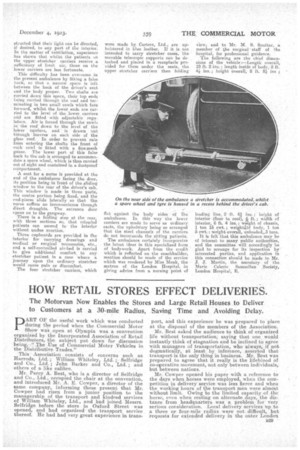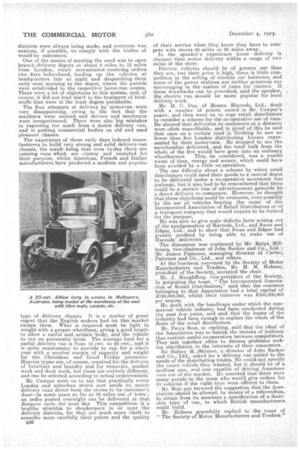HOW RETAIL STORES EFFECT DELIVERIES.
Page 13

Page 14

If you've noticed an error in this article please click here to report it so we can fix it.
The Motorvan Now Enables the Stores and Large Retail Houses to Deliver to Customers at a 30-mile Radius, Saving Time and Avoiding Delay.
pART OF the useful work which was conducted during the period when the Commercial Motor Show was open at Olympia was a convention organized by the Incorporated Association of Retail Distributors, the subject put down -for discussion being, :`f The Use of Commercial Motor :Vehicles in the -Distributive Trades."
This • Association consists of concerns such as Harrods, Ltd: ; William Whiteley, Ltd. ;-Selfridge and Co., Ltd. ; John Barker and Co., Ltd. ; and others of a like calibre. •
Mr. Percy A. Best, who is a director of Selfridge and Co., Ltd., -occupied the chair at the convention, and introduced Mr. A. E. Cowper, a director of the same company,. informing those present that Mr. Cowper had risen from a junior position to the manaFership of the transport and kindred services of William Whiteley, Ltd., and had joined Messrs. Selfridge before the store in Oxford Street was opened, and had organizedthe transport service thereof. He had had very great experience in trans
port, and this experience he was prepared to place at the disposal of the members of the Association.
Mr. Best asked the audience to think of organized life without transportation, saying that one would instantly think of stagnation and be inclined to agree with managers of transportation, who always, if not dogmatically, at least by inference, asserted that transport is the only thing in business. Mr. Best was prepared to agree that it really is the lifeblood of co-operative movement, not only between individuals, but between nations.
Mr. Cowper opened his paper with a reference to the days when horses were employed, when the competition in delivery service was less fierce and when the working hours of the transport men were almost without limit. Owing to the limited capacity of the horse, even when resting on alternate days, the distance from headquarters was a problem for -very serious consideration. Local delivery -services up to a three or four-mile radius were -not difficult, but requests for extended delivery in the outer London
districts were always being made, and everyone was anxious, if possible, to comply with the wishes of would-be customers.
One of the means of meeting the need was to open branch delivery depots at about 8 miles, to 12 miles from London, which necessitated receiving orders two days beforehand, loading up the vehicles at headquarters late at night and despatching them early next morning to the depot, where the parcels were subdivided to the respective horse-van routes. There were a lot of objections to this system, and, of course, it did not lend itself to the transport of food. stuffs that were in the least degree perishable.
The first attempts at delivery by motorvan were very disappointing, owing to the fact that the machines. were untried and drivers and mechanics were inexperienced. There were also big mistakes in expecting too much from a motor delivery van, and in putting commercial bodies on old and used pleasure chassis.
The experience of those early days induced manufacturers to build very strong and solid delivery-van chassis, the result being that even to-day there are running vans which are clumsy and unsuited for their purpose, whilst American, French and Italian manufacturers have produced a medium and popular type of delivery chassis. It is a matter of great regret that the English makers had let this market escape them. What is required must be light in weight with a proper wheelbase, giving a good length to allow a useful and. artistic'body, and the vehicle to run on pneumatic tyres. The average load for a useful delivery van is from 10 cwt. to 20 cwt., and it is quite unnecessary to provide to run for a whole year with a surplus margin of capacity and weight for the Christmas and Good Friday pressures. Heavier types are, of course, required for the delivery of furniture and laundry and for removals, market work and dock work, but these are entirely different, and can be selected according to actual requirements.
Mr. Cowper went on to say that practically every London and suburban stores now sends its motor delivery vans direct from the stores to its customer's door—in some cases so far as 30 miles out of town ; an order posted overnight can be delivered at that distance early the next day. This competition is a healthy stimulus to shopkeepers in or near the delivery districts, for they are much more likely to consider more carefully their prices and the quality B30 of their service when they know they have to compete with stores 20 miles or 30 miles away. In the speaker's experience horse delivery is cheaper than motor delivery within a range of two miles of the store.
Electric vehicles should be of greater use than they are, but their price is high, there is little competition in the selling of electric car batteries, and some of the power stations are neither generous nor encouraging in the matter of rates for current. If these drawbacks can be remedied, said the speaker, the electric van simuld be more popular for local delivery work.
Mr. H. C. Day, of Messrs. Harrods, Ltd., dealt with a number of points raised in Mr. Cowper's paper, and then went on to urge retail distributors to consider a scheme for the co-operative use of vans. He showed that deliveries to customers at a distance were often unprofitable, and in proof of this he said that once on a certain road in Dorking he saw no fewer than five London distributing houses represeated by their motorvans. He stopped to see the merchandize delivered, and the total bulk from the whole of the five would have gone into an ordinary wheelbarrow. This, he considered, was a woeful waste of time, energy and money, which could have been avoided by a little co-operation.
The one difficulty about a scheme by which retail distributors could send their goods to a central depot to be delivered under a co-operative movement was jealousy, but it also had to be remembered that there could be a certain loss of advertisement gainable by\ a direct delivery to customers. However, he thought that these objections could be. overcome, even possibly by the use of vehicles bearing the name of the Incorporated Association of Retail Distributors or of a transport company that would require to be fOrmed for the purpose. He was able to give some definite facts arising out of the amalgamation of Harrods, Ltd., and Swan and , Edgar, Ltd. and to show that Swan and Edgar had greatly profited by beinz -able to make use of Harrods' deliveries.
The .discussion was continued by Mr. Ralph Minimum, vice-chairman of John Barker and Co., Ltd:; Mr. Ja,mes Paterson, managing director bf Carter,
Paterson and Co., Ltd., and others.
At the' linieheon convened by the Society of Motor Manufacturers and Traders, Mr. H. M. Hobson, president of the Society, occupied the chair. Mr. J. Maughfling, vice-president of the Society, in proposing the toast, "The Incorporated Association of Retail Distributors," said that the, concerns belonging to that Association had a total capital of 2120,000,000, whilst their turnover was £350,000,000 per annum.
He dealt with the handicaps under which the cornMercial vehicle industry had been conducted during the past few years, and, said that the losses of the -industry had been enough to replace the whole of the fleets of the retail distributors.
Mr. Percy Best, in replying, said that the ideal of the Association was to banish the streaks of jealousy that restrict Useful co-operation between competitors. They met together often to discuss problem seeking elucidation in the interests of their consumers. Sir Sidney Ma Skinner, a director of John Barker and Co., Ltd., asked for a delivery, van suited to the needs of the distributing trades. Be could not specify the exact vehicle they wanted, but it should be of a medium size, and 'one capable of driving American ears out of the market. He asserted that there were many people in the room who would give orders for 50 vehicles if the right type were offered to Them.
Mr. Best put forward the suggestion that the Association should be allowed, by means of a, referendum, to obtain from its members a specification of a desirable type of van, to which British manufacturers could
Mr. Hobson gracefully replied to the toast of "The Society of Motor Manufacturers and Traders."


































